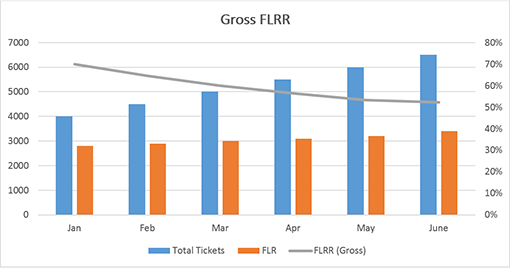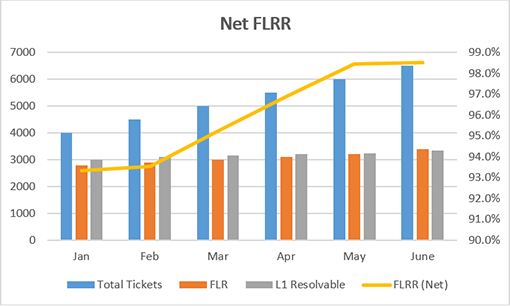Date Published June 20, 2016 - Last Updated December 15, 2016
First Level Resolution (FLR) is a simple enough metric. It answers the question, “How many resolutions were we able to provide without hierarchical escalation?” It’s a measure of efficiency and effectiveness, showing whether your Level 1 analysts are resolving a high percentage of the contacts that come their way. However, there are two major ways to measure FLR.
Gross Versus Net
Gross FLR rate (FLRR) is the percentage of all tickets you were able to resolve at Level 1. Net FLRR is the percentage of Level 1 Resolvable tickets you did in fact resolve at Level 1. The gross FLRR formula look like this:
Gross FLRR = Tickets Resolved at Level 1 ÷ Total Number of Tickets
If you had 4,000 tickets last month and resolved 2,800 of them at Level 1, you have a 70 percent gross FLRR.
To calculate Net FLRR, you first need an explanation of what Level 1 Resolvable means. It’s fairly straightforward, but determining what is or is not resolvable at Level 1 requires some work up front. The support center management, in concert with other managers, decides what Level 1 analysts have the access and authority to do. For example, if your Level 1 analysts are authorized to add people to Active Directory groups, then a request for access to the resources accessible to an AD group becomes Level 1 Resolvable. A Level 1 analyst can access AD and add a user to the group without further escalation or consultation. If Level 1 analysts do not have authority and access to add to AD groups on the other hand, the request cannot be resolved at Level 1 and must be escalated elsewhere.
The Net FLRR formula looks like this:
Net FLRR = Tickets Resolved at Level 1 ÷ Total Level 1 Resolvable Tickets
If you had 4,000 total tickets last month and 3,000 were determined to be Level 1 Resolvable, and of those, Level 1 did in fact resolve 2,800 tickets, your net FLRR is 2,800 ÷ 3,000, or 93 percent.
Now if we’re using Level 1 Resolvable tickets, shouldn’t that number be 100 percent? Well, ideally, yes, but there are always mistakes made, new analysts who don’t know that they can and should fulfill the request or solve the incident, or analysts who are simply feeling so busy that they do not take the time to resolve the issue themselves, preferring to pass it along.
Which Should We Measure?
It’s no secret that managers—not only in the support center but across the business—like nice, high numbers, except when high equals bad. Managers also don’t like to measure things over which they have little or no control, because they feel—sometimes correctly—that their senior management will hold the numbers against them. Because of these subjective factors, some organizations have preferred using the net FLRR measure, knowing that they will have high numbers and “look good.”
Managers don’t like to measure things over which they have little or no control.
Is net FLRR a valid metric? Yes. Is it better (or worse) than gross FLRR? Not really. It depends on what you are asking. If you are asking how effective your analysts are at doing work that is within their boundaries, then net FLRR is a perfectly acceptable measure. If, on the other hand, you want to see how effective your Level 1 is at handling the broad range of issues the support center has to handle, then gross FLRR is the right measure. If you are going to measure only one of these, measure gross FLRR.
Should We Measure Both?
If you want to take the time to determine what is and is not Level 1 Resolvable, then by all means measure both gross and net FLRR. You will get two different pictures of your support center’s effectiveness and efficiency to help you determine how you can improve.
Let’s say, for example, that you continue to measure gross FLRR, and you notice that month after month, your rate goes down as the total number of tickets goes up.

What we now know is that despite the fact that Level 1 is resolving more tickets each month, they are losing ground in terms of what they are able to accomplish overall. This trend tells us that one or more of the following might be true:
- Analysts might not have up-to-date knowledge
- The complexity of incidents and requests is increasing
- There are too many tickets for the staff to handle
This situation might be a good case for measuring net FLRR as well. Suppose this same organization has net FLRR numbers that look like this:

In this case, Level 1 is doing an excellent job of resolving almost all of what they can. Where the ground is being lost is outside the realm of Level 1. This is a good indicator that it is time to re-evaluate your Level 1 capabilities and start moving toward a shift-left strategy to reduce the load and the cost of escalations. This approach has the beneficial side effect of increasing the speed of most resolutions. Consider revisiting your available knowledge base and make more current documentation available to Level 1. Consider more training or other methods of more closely matching Level 1 capabilities with the demands of the contemporary organization.
It is time to re-evaluate your Level 1 capabilities and start moving toward a shift-left strategy.

According to the HDI 2015 Support Center Practices & Salary Report, the average gross FLRR across the industry is 68 percent. This industry report is a great source of information about industry trends, including metrics such as FLRR.
Roy Atkinson is HDI's senior writer/analyst, acting as in-house subject matter expert and chief writer for SupportWorld articles and white papers. In addition to being a member of the HDI International Certification Standards Committee and the HDI Desktop Support Advisory Board, Roy is a popular speaker at HDI conferences and is well known to HDI local chapter audiences. His background is in both service desk and desktop support as well as small-business consulting. Roy's blogs regularly appear on HDIConnect, and he is highly rated on social media, especially on the topics of IT service management and customer service. Roy is a cohost of the very popular #custserv (customer service) chat on Twitter, which celebrated its fifth anniversary on December 9, 2014. He holds a master’s certificate in advanced management strategy from Tulane University’s Freeman School of Business, and he is a certified HDI Support Center Manager. Follow him on Twitter @HDI_Analyst and @RoyAtkinson.